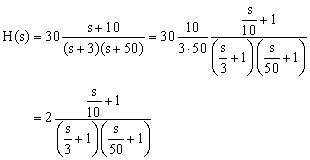
This document will discuss how to actually draw Bode diagrams. It consists mostly of examples.
A transfer function is normally of the form:

As discussed in the previous document, we would like to rewrite this so the lowest order term in the numerator and denominator are both unity.
Some examples will clarify:

Note that the final result has the lowest (zero) order power of numerator and denominator polynomial equal to unity.

Note that in this example, the lowest power in the numerator was 1.

In this example the denominator was already factored. In cases like this, each factored term needs to have unity as the lowest order power of s (zero in this case).
The next step is to split up the function into its constituent parts. There are seven types of parts:
We can use the examples above to demonstrate again.

This function has
The complex conjugate poles are at s=-1.5 ± j6.9 (where j=sqrt(-1)). A more common (and useful for our purposes) way to express this is to use the standard notation for a second order polynomial

In this case


This function has


This function has
The rules for drawing the Bode diagram for each part are summarized on a separate page. Examples of each are given later.
After the individual terms are drawn, it is a simple matter to add them together. See examples, below.
These examples are compiled on the next page.